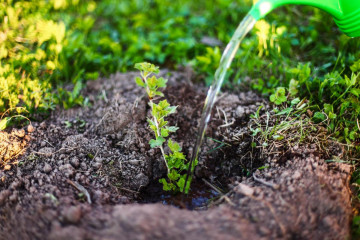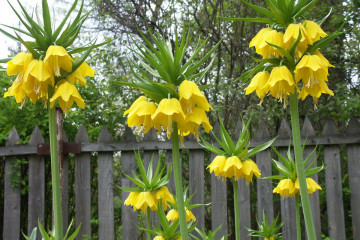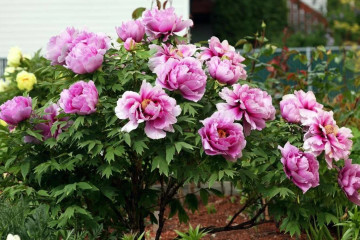When to replant peonies in spring, summer and autumn
Content:
Peonies are flowering perennials that do not need regular replanting. But once every few seasons, they should be dug up, divided into parts and transferred to another site. About when it is better to transplant peonies and how to do it correctly, further.
Why do you need a transplant

The best period for replanting is autumn.
One of the features of peonies is their fragile, deep-lying root system. Therefore, the culture is going through a transplant painfully. After this procedure, the delenki are restored for a long time, and they often begin to bloom only after 2-3 years.
It is important to know when to replant peonies and how to do it carefully, minimizing plant stress. It is impossible to do without this procedure. Upon reaching the age of 6-7 years, the bushes begin to give less lush flowering, the flowers become smaller. Sometimes they stop appearing altogether. This is due to the fact that the roots thicken, suffer from nutritional deficiencies.
Thickening of the root system
The root system in an adult plant looks like a dense plexus of thick roots, forming nodes. From the inside, they are often empty, rotten. The underground parts often become a haven for rodents, which make passages and burrows inside. As a result, root growth slows down significantly, and the green mass stops developing, not receiving sufficient nutrition.
When the root system thickens and the culture stays in the same place for a long time, soil depletion occurs. Plants begin to suffer from a deficiency of essential micronutrients.
Top dressing, which is usually applied under young bushes during planting, lasts for several years. Then the peonies are fertilized every year, but this does not fully satisfy their needs for nutrients, since the culture receives the bulk of them from the soil.
The root system of peonies is located deep below the surface of the earth, does not spread to the sides, and the fertile layer lies at a depth of about 20 cm. Therefore, the roots cannot absorb the required amount of trace elements, the plants do not have enough strength for active growth and frequent flowering.
Choosing a new location
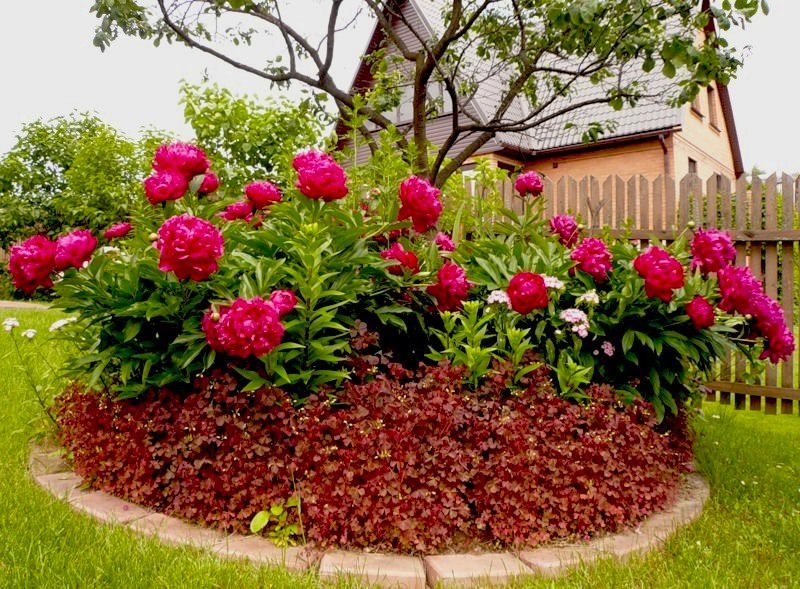
Culture does not like strong winds and drafts
The main requirement that a new site must meet is good illumination. Peonies are a light-loving culture. They can grow in light partial shade conditions. But if for at least 1 hour a day they remain in a dense shade, for example, from trees or buildings, then the flowering worsens, the bushes wither.
- The future flower bed with peonies should be ventilated so that the plants do not get attacked by the fungus.
- Close proximity to buildings is not recommended for the reason that brick or concrete walls reflect heat in the heat of the summer. This can burn the plants.
- And nearby shrubs or trees can deprive peonies of nutrients and water.
Therefore, when deciding when to transplant peonies to another place, it is important to pay attention to the selection of the site. It is better to leave a central place for them in the garden or in the flower bed so that trees and buildings do not block the bushes from light.
The culture does not make such high demands on the composition of the soil. She feels comfortable on any garden soil.The best option is considered to be drained loamy soil.
The soil for the normal development of the roots must be soft, thoroughly and deeply cultivated, otherwise the root system will remain in the upper layer of the soil. In summer, it dries up quickly, which threatens the bushes with a lack of moisture and growth retardation, lack of flowering. If the soil in the new area for peonies is scarce, it must be enriched with fertilizers.
Features of planting at different times of the year

Healthy and intact suction roots are the key to successful survival of young plants
To determine how to plant peonies and when to do it, you need to have an idea about the features of their root system.
- The central, most massive part of it serves as a kind of storehouse for nutrients. It is she who supports the plant during the wintering period, protects from the cold.
- Thinner processes branch off from it. The density and abundance of flowering of the bushes depend on their condition, since replacement buds and young stems are laid on these roots. Shoots in the form of light, thin root shoots are formed in autumn, in September.
- Another important part of the root system is the suction shoots, which can be represented as a thin web that collects micronutrients and moisture. In order not to damage it, when planting peonies, it is necessary to prepare a wide and deep hole.
In order to choose the right moment when you can transplant peony bushes, you need to know the peculiarities of culture adaptation at different times of the year.
In the spring
The spring transplant of peonies has one significant drawback: it is easy to be late with this work.
With the end of winter, the plants wake up. There is a rapid build-up of suction roots. If during this period you begin to transplant the bush, these roots can be damaged, which threatens the death of the entire plant. It will not receive nutrition and will quickly use up the supply that has accumulated in the massive central roots.
If you still transplant the bushes after wintering, then this should be done as early as possible, immediately after the snow cover disappears, before the plants awaken. At this point, the roots do not have time to wake up. They begin to develop at a new site.
In summer
In June and July, the culture is actively increasing its green mass, and the suction roots have time to grow and gain a foothold in the ground in the spring. Their development slows down, but the roots actively extract moisture and nutrients. When buds form on the bushes, the main forces of the plant are directed to the flowers.
If peonies are transplanted in the summer, then the suction roots are inevitably damaged, the nutrition of the bushes deteriorates. On the new site, neither the development of new roots nor adaptation of the old ones take place. The reserves already made by plants become the only source of nutrition. But they are not enough for wintering, which often leads to the death of peonies.
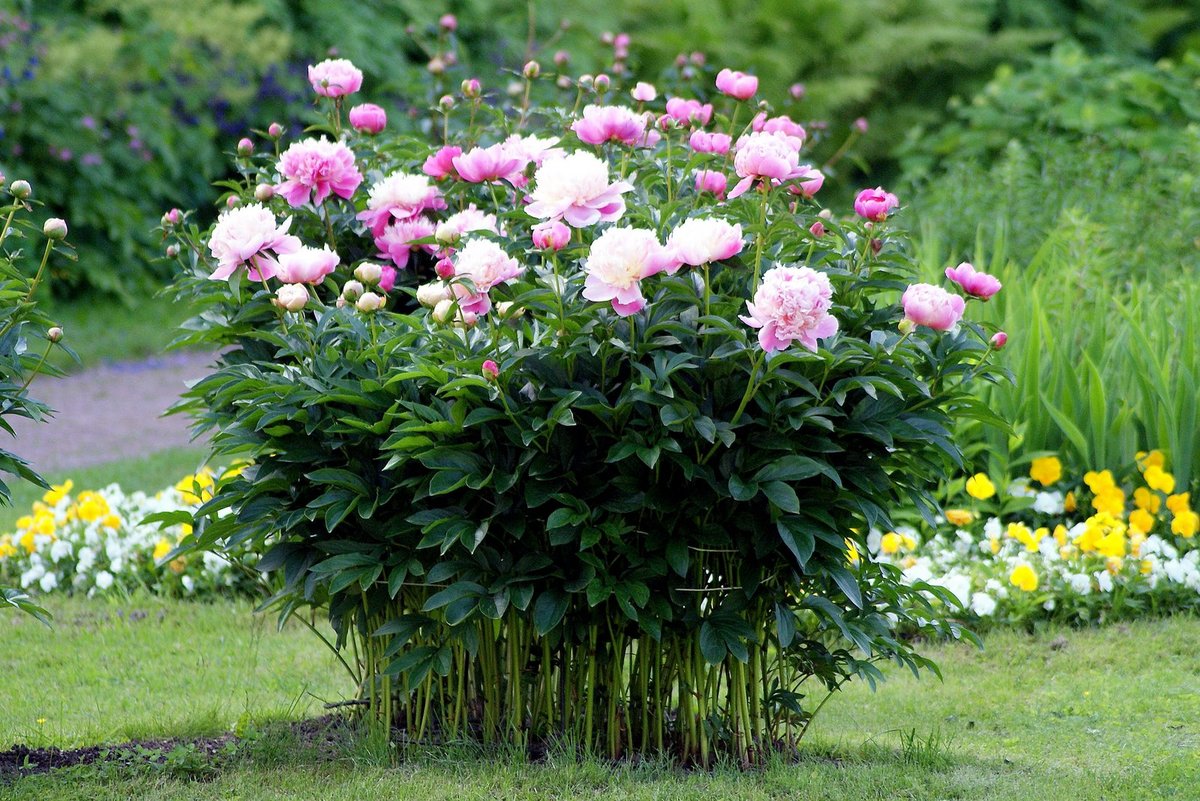
According to statistics, most of the bushes transplanted in the summer period wither within a month.
In autumn
In autumn, peonies stop blooming and begin to prepare for wintering. The green mass is not growing. Plants provide a supply of nutrients. Their absorbing roots actively extract nutrients and grow rapidly. This period is considered the best when planting peonies. The bushes are ready to be divided and moved to a new site. The roots are ready for the winter cold.
For normal rooting of the culture, one month is enough. Before the onset of frost, sucking roots have time to grow in peonies. In the northern regions, you can plant it already in mid-August. In the Middle Lane, the optimal time is in September, and in the south it lasts until mid-October.
On average, at the end of September, there is a period of active growth of pantry roots, where plants retain a supply of necessary elements. They become denser and more voluminous. The transplant should be carried out before this time, otherwise the bush will not survive in the winter.
Preparing the transplant site
It is necessary to start preparing a flower bed for peonies 2-4 weeks before the planned planting date, so that the soil will settle and compact. Planting pits are being prepared for the culture.
- Their width and depth should be about 0.5 m.
- The bottom is thoroughly loosened.
- Before planting, a mixture of humus with garden soil is poured into the pit with the addition of 200 g of superphosphate and 500 g of bone meal.
If the site is located in a lowland, then the flower beds must be raised, and a drainage layer must be equipped in the planting pits. To do this, they should be deepened by 20 cm and filled with coarse sand, gravel.
Some gardeners, when planting peonies, resort to the trench method. When it becomes necessary to transplant a large number of plants, instead of individual holes, they dig trenches 0.5 m wide and deep.
How to dig up peonies correctly
When replanting, it is necessary to preserve the integrity of massive roots, in which the supply of nutrients is preserved, as well as young root outgrowths containing buds.
Stages of work:
- Dig in the plant at a distance of 40-50 cm from the extreme branches. To do this, use a pitchfork.
- Take a bayonet shovel and carefully move the lump with the plant, lifting it up. This should be done slowly so as not to injure the fragile root system. It is impossible to pull it out of the ground, holding on to the branches.
- Cut the stems so that their length is approximately 10 cm.
- Rinse the excavated roots with water in order to understand how to separate them.
- Leave the planting material for several hours to dry in a shaded place so that the roots acquire elasticity and do not crack.
How to split
Each division must have:
- a section of a thick root;
- several young shoots;
- 3 to 5 healthy kidneys.
After trimming, the cut should be carefully examined. It must not be damaged. If rotten or dried out areas are found on it, they should be removed.
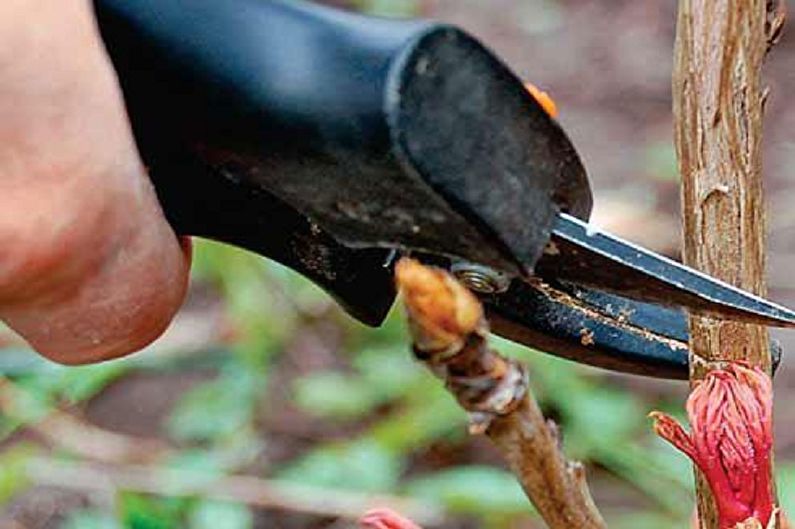
Sprinkle the cut sites with activated carbon
Step-by-step instructions for landing in a new location
A rail is placed across the landing pit. It serves as a reference point for measuring the distance to which the kidneys need to be buried. In tree peonies, they should be located at the same level with the surface of the soil, 4 cm is enough for herbaceous varieties. Excessive deepening leads to the fact that the culture does not bloom, and insufficient - to freezing in winter.
Peonies should be planted as follows:
- Focusing on the rail, seedlings are lowered into the planting pit.
- Sprinkle.
- Watered and reintroduced the earth.
- The trunk circle is mulched with sawdust or peat.
Further care
Caring for peony seedlings includes several agrotechnical operations:
- Watering. In autumn it is moderate, taking into account atmospheric precipitation. During the first month after the bush has been transplanted, it is watered no more than 3 times. In the spring, water procedures are carried out more often.
- Loosening, weeding, mulching. By adding a layer of mulch, growers reduce moisture evaporation and prevent weeds.
- Preparation for wintering. To insulate the roots, they are sprinkled with a layer of peat, sawdust or spruce branches 15 cm or more thick.
- Prevention. In the spring, seedlings are sprayed to protect them from insect attacks and diseases.
If you transplant peonies in the right way, then the first flowers will appear on young plants next year. Leaving them on the bushes is not worth it so that the peonies do not expend energy and better endure the winter. In the second year, one flower is allowed to bloom.Full flowering begins in the third year.
